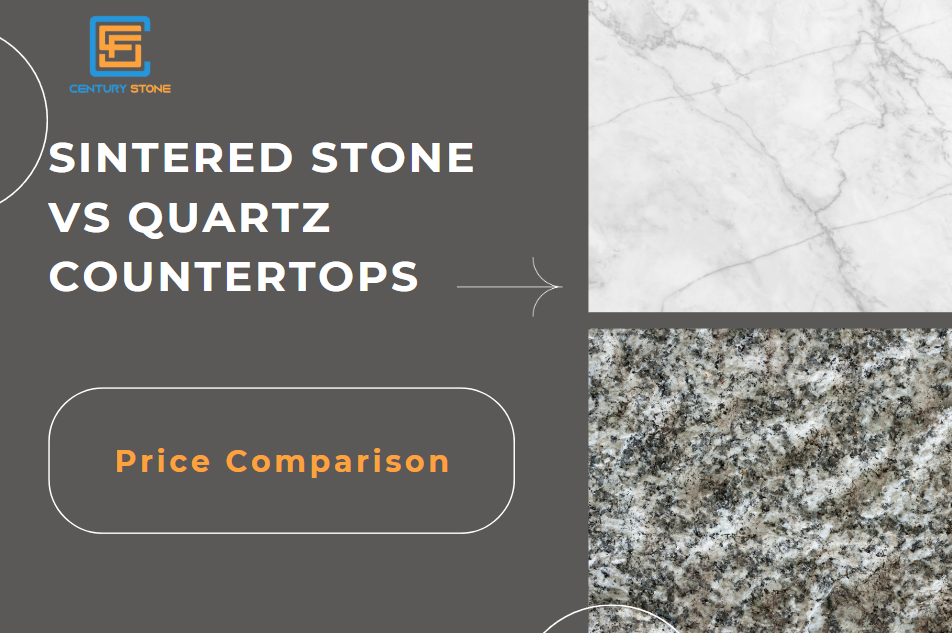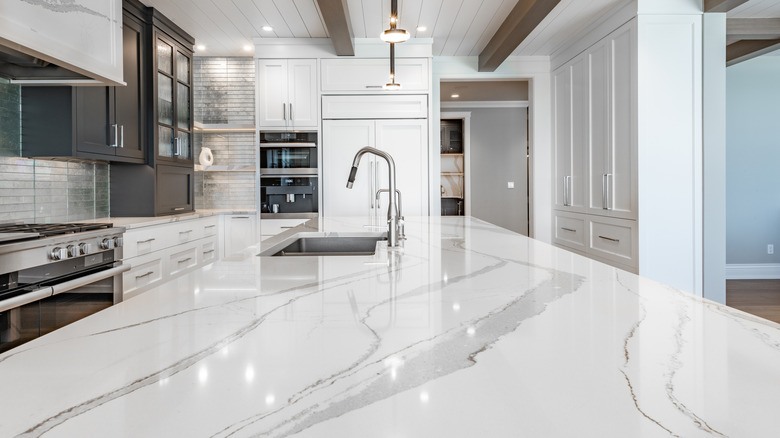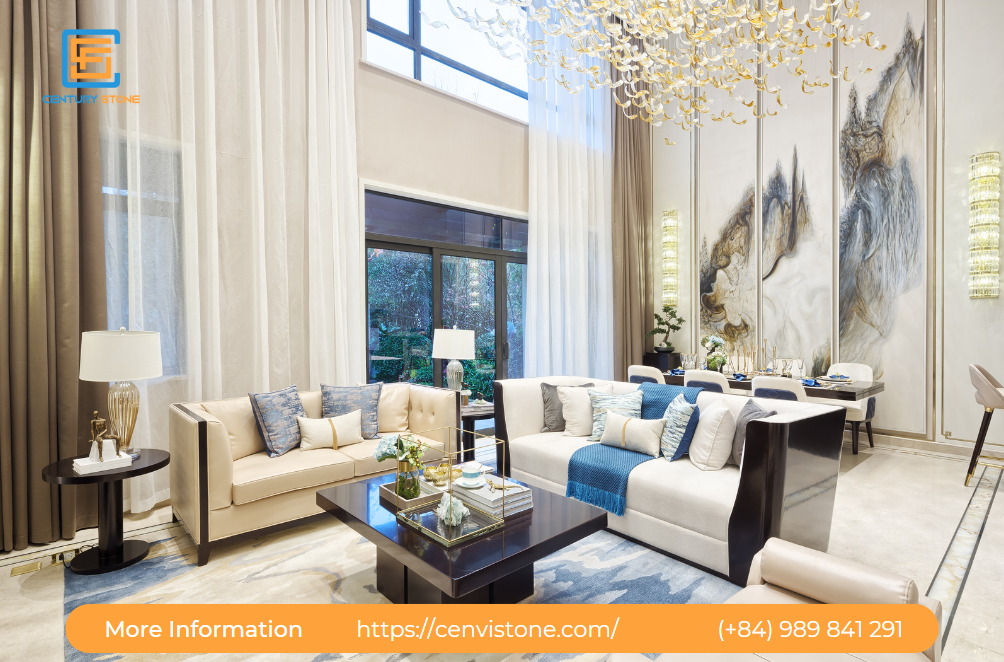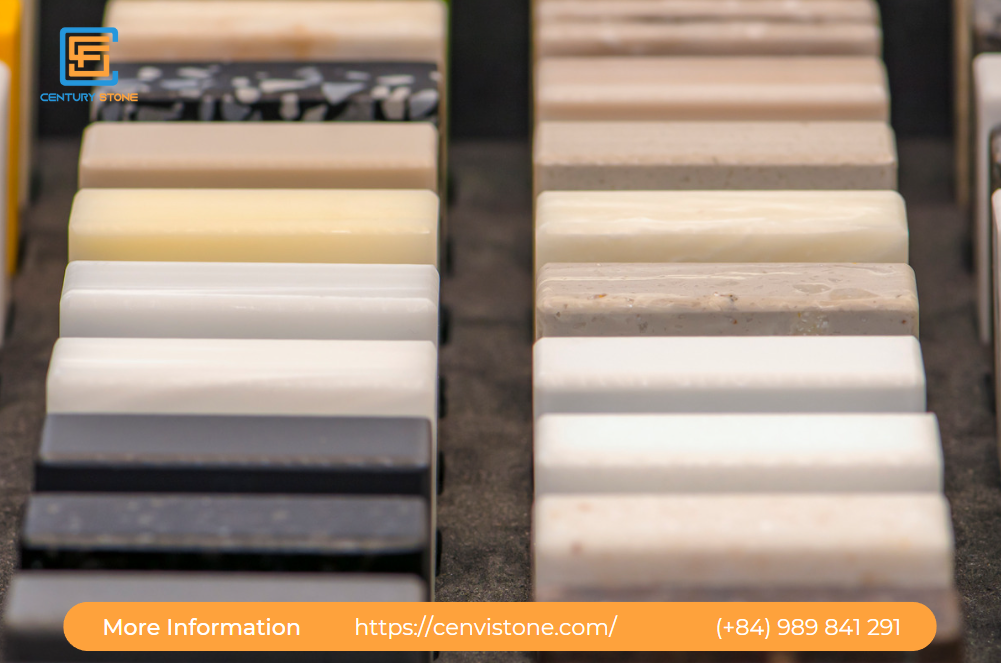Sintered Stone vs Quartz Countertops - Key Differences Comparison 2024

Sintered Stone vs Quartz Countertops - Key Differences Comparison 2024
Introduction
Are you contemplating a kitchen upgrade and torn between sintered stone and quartz countertops? Deciding on the perfect surface can be challenging, as both offer a stunning and durable workspace. Understand the unique benefits and key differences between these trendy countertop materials as we delve into a thorough comparison. Let's explore what sets Sintered Stone vs Quartz apart at what would be the best option for your countertops.
What is Sintered Stone and Quartz?
Sintered stone and quartz are both fabulous choices for countertops, but each comes from a different recipe of sophistication. Sintered stone is a newcomer, a mix of natural minerals like quartz, porcelain, and glass ground to a powder and sintered under mighty pressure and heat. It's Mother Nature's elements turned into an incredibly resilient slab.
Quartz, on the other hand, is composed of natural quartz stone, resin binders, and pigments. Squished and vibrated under intense pressure, it forms a dense and captivating surface. Both man-made, each with unique charms, yet not quite the same.
1. Price Breakdown
When it comes to the price tag, quartz and sintered stone don't sing the same tune. You're likely to notice quartz countertops sporting prices from around $80 to $150 per foot, capturing hearts with designs that don't break the bank. Remember, this includes the cost of installation but gives the cold shoulder to the 8% GST.
On the flip side, sintered stone marches to the beat of $150 to $300 per foot, asking a bit more from your wallet. This figure also wraps in installation charges, but like its counterpart, forgets to include GST. Both materials bring their own value to your abode, so weigh those long-term benefits against the upfront outlay. After all, a countertop is a stage for life's little dramas – you'll want it to be a worthwhile investment.

Price Breakdown
2. Durability
In the battle of brawn, both sintered stone and quartz countertops flex considerable muscles. They're the champions of durability, ready to stand up to your kitchen's high demands. You'll find sintered stone tough against the scorch of hot pots and the accidental knife slip, thanks to its extraordinary resistance to scratch and heat. Quartz parries with similar toughness, shrugging off scratches, stains, and impacts with ease.
But durability doesn't end at resisting wear and tear; it’s also about enduring beauty. Each of these materials is non-porous, meaning bacteria and grime have nowhere to hide, ensuring your countertop remains hygienic and fresh as a daisy for the long haul. Whether you choose the modern elegance of sintered stone or the classic allure of quartz, rest assured your kitchen’s centerpiece is built to last.
3. Style
Both quartz and sintered stone bring fashion to your countertop's function in spades. Quartz shines with its broad color palette, ranging from stark whites to deep, moody hues. Marble-like patterns, speckled designs, and just about everything in between mean quartz can suit any kitchen personality. A chameleon for your kitchen motif, really.

Style
Sintered stone plays its own impressive style card, mastering the art of imitation. Wood, concrete, or even stone textures, it can mimic them with striking accuracy. If pushing the envelope of design intrigues you, sintered stone offers avant-garde patterns and finishes that might tickle your fancy. Imagine a surface that looks like cut marble or raw, industrial concrete.
Both materials are trendsetters, ready to complement a diverse array of aesthetics, from clean minimalism to ornate traditionalism.
4. Usability
When it comes to usability, think of quartz and sintered stone as the trusty sidekicks in your kitchen adventures. Quartz, with its reliable and non-porous nature, is virtually maintenance-free and stands up valiantly to daily spills and splatters. Plus, it's so simple to clean, just a wipe down with soap and water, and you're done!
Sintered stone steps it up a notch in the heat resistance department. You could plop a hot pan down without a worry (although using a trivet is always a wise move). Additionally, it's dyed in the wool, meaning the color runs through the entire slab, so if a scratch does happen, it's less noticeable.
Both are steadfast when it comes to resisting bacteria and they're safe for food contact, which is a breath of fresh air for any home chef. They stand their ground against the perils of a busy kitchen, but remember to always use a cutting board – they may be durable, but no surface is invincible.
5. Maintenance
Now, let's talk maintenance – it's the nitty-gritty nobody loves but everyone has to think about. Fortunately, both sintered stone and quartz require minimal effort to stay in tip-top shape. For sintered stone, it's as easy as wiping down with mild soap and water. Rarely will you need anything else, but don't forget, some may ask for periodic sealing to keep them looking immaculate.

Maintenance
Quartz countertops, while also a breeze to maintain, tell a similar story sans the sealing. Regular cleaning, plus a swift hand to mop up spills, keeps them looking their Sunday best. Just steer clear of heat-direct contact – no countertop likes that! If your lifestyle has you racing against the clock, these materials are sure to keep pace, providing a hassle-free backdrop to life's everyday spills and thrills.
6. What Are the Pros and Cons of Quartz?
Quartz countertops are the life of the party – durable, wearing a spectrum of colors, and with an easy-going personality when it comes to cleaning. They relish the hustle and bustle of a well-loved kitchen, brushing off scratches, stains, and water like small talk.
Pros:
- Durability: With a 7 out of 10 on the Mohs hardness scale, quartz resists scratches, chips, and cracks like a champ.
- Low Maintenance: Its non-porous nature waves goodbye to sealing and says hello to simple cleaning with soap and water.
- Versatile Aesthetics: You'll find quartz in every costume, from natural stone lookalikes to bold, modern hues.
- Water-Resistance: The non-porous surface means spills don't sink in, keeping stains at bay.
- Hygienic: This material doesn't give bacteria, mold, or mildew a foothold, making for a cleaner cooking space.
Cons:
- Heat Sensitivity: Quartz isn't the friend of hot pots and pans; it's best to keep them apart without a trivet in between.
- UV Sensitivity: The sun's rays can be unkind, fading your countertop's vibrant look over time.
So, who's quartz perfect for? Home cooks who want low maintenance heart and hearth, those who dance with colors and styles, and folks who hold hygiene in high esteem. If that's you, quartz could just be your kitchen's soulmate. [Insert customer review praising the low maintenance and beauty of their quartz countertop]
Top 5 Features:
- Scratch-resistant
- Stain-resistant
- Wide range of colors and patterns
- Non-porous and hygienic
- Easy to clean
Five Benefits:
- No need for yearly sealing
- Durable surface that lasts
- Matches any interior design
- Resists bacteria growth
- Super easy, stress-free upkeep
Two Cons:
- Can be damaged by excessive heat
- Potential for discoloration in sunlight
Best For: Busy homeowners seeking style without sacrificing convenience, families in need of a robust yet easy-to-maintain surface, and design enthusiasts looking for variety without complexity.
Cenvistone – Vietnam’s Trusted Name in Quartz Materials
When comparing sintered stone and quartz countertops, one name stands out in the world of quartz: Cenvistone. As Vietnam’s trusted provider of high-quality quartz materials, Cenvistone offers a range of durable and stylish options that rival even the most advanced sintered stone surfaces. With a reputation built on precision craftsmanship and affordability, Cenvistone quartz countertops provide a perfect blend of beauty and practicality for any modern home. Whether you’re drawn to the elegance of marble-like designs or prefer a more minimalist look, Cenvistone’s quartz collections offer a wide array of choices to suit your needs.
- Calacatta Collection: Featuring bold veins and timeless elegance, inspired by Italy’s finest marble.
- Carrara Collection: Subtle and serene, with soft veining and a cloud-like appearance.
- Exotic Collection: Dynamic patterns and bold contrasts for those seeking a statement piece.
- Basic Collection: Sleek, minimalist designs in neutral tones, perfect for modern interiors.
- Fabrication Products: Custom quartz countertops, islands, and tables designed for your unique space.
Sintered Stone vs Quartz - FAQ
What is the disadvantage of sintered stone?
The primary disadvantage of sintered stone is its susceptibility to impact damage. While it's tough against heat, stains, and scratches, a hard knock can crack or chip it, especially along the edges. Plus, it's often pricier than other countertop materials, so consider your budget. [Insert customer review detailing a chip repair experience]
Does sintered stone stain easily?
No, sintered stone doesn't stain easily. Its non-porous nature means spills sit on the surface rather than soak in, giving you time to wipe them away without a trace. It tackles most household spills like a pro, keeping your kitchen pristine. [Insert care guide snippet on removing common spills from sintered stone]
Does sintered stone crack easily?
Usually not, sintered stone is designed to resist cracking under normal conditions. It's quite strong and durable. However, if it's not installed correctly or if it takes a hefty blow from a heavy object, it could crack or chip, particularly at weak points like edges or cutouts. [Insert testimonial from users praising sintered stone's durability]
What are quartz weaknesses?
Quartz's kryptonite lies in its sensitivity to heat and sunlight. Excessive heat can cause it to warp or crack, so hot pots and pans are a no-go without protection. Additionally, prolonged exposure to direct sunlight may fade its colors, leading to inconsistencies in your countertop's look

 en
en
 Vietnamese
Vietnamese
 English
English
 Chinese
Chinese